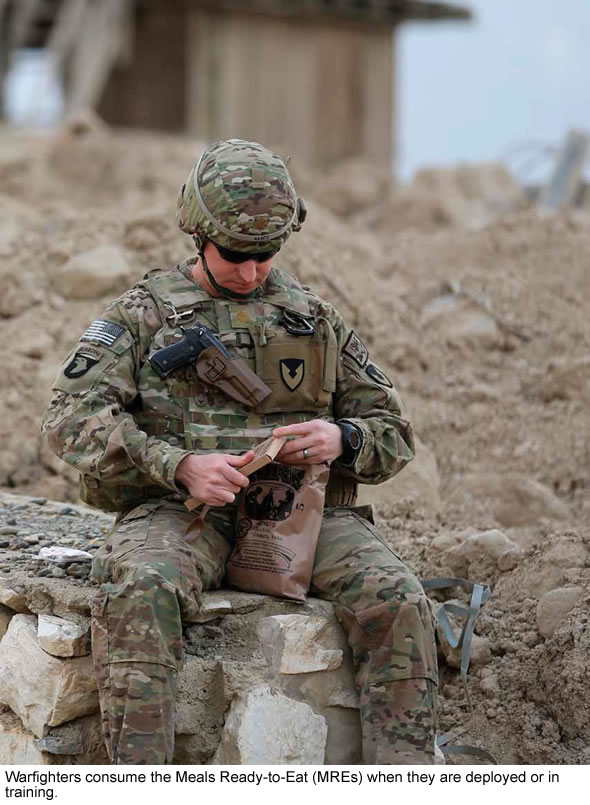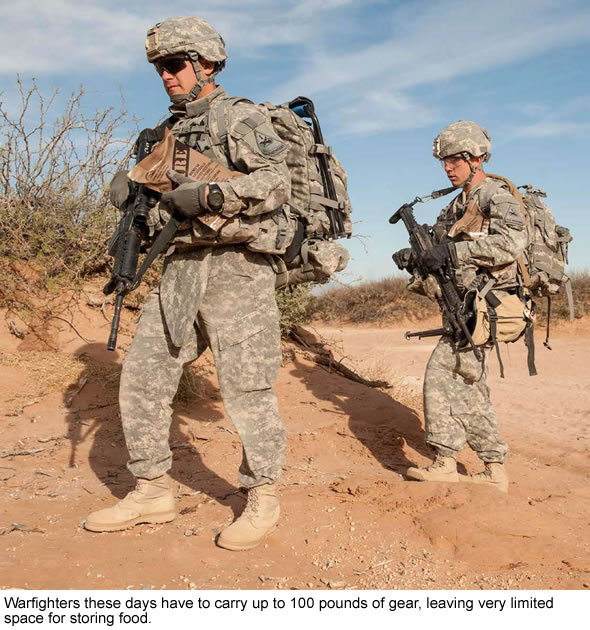EnWave Potentially Solving Major Military Issue
A few weeks ago, EnWave Corporation (TSXV:ENW – $0.97 CAD & OTC:NWVCF – $0.81 USD & Frankfurt:E4U – €0.64) entered into a contract with the US Army Natick Soldier R&D Center to jointly develop low weight, high quality, nutritious field rations for the U.S.
This opportunity for EnWave is enormous, as potentially hundreds of thousands of men and women in active duty could be served Radiant Energy Vacuum (REV) dried rations.
To give more color on this contract and its potential, we were fortunate to sit down with Dr. Tom Yang, Senior Food Technologist at the U.S. Army Combat Feeding Directorate (CFD), and a strong advocate of EnWave’s REV technology.
The Combat Feeding Directorate
Under the auspices of the Department of Defense (DoD), the CFD is responsible for the research, development, engineering, integration, and technical support for the entire family of rations for the Army, Navy, Airforce and even NASA.
Unique requirements drive the Combat Feeding mission: ensuring that those brave fighters are provided healthy, high quality meals anywhere in the world. As the military draws down in size, individual combatants and small units will be forced to complete complex tasks with fewer available resources. The increased reliance on personal performance abilities requires investment in food science and equipment technologies that enable and improve combat effectiveness.
The CFD program is driven by user recommendations and feedback that the organization obtains from annual field tests of rations. After all, in order to accomplish the mission of providing the highest quality rations to servicemen and women, it is imperative that the development of new combat foods is fueled by their wants, needs, and ideas.
MRE – A Lesson in Performance Nutrition
Warfighters consume the rations when they are deployed or in training. These are called Meals Ready-to-Eat (MREs). Deployed service members have been relying on them for more than 30 years. Since research and development of the MRE began in 1959, the meals have improved significantly, mainly due to feedback on satisfaction from warfighters, but also because of technological innovation, and improved understanding of performance oriented nutrition and operational mission performance demands.
In total, there are 24 different MREs designed to support general purpose feeding requirements and to offer variety and acceptability that serve the broad demographic profile of the military population.
The MRE is intended as a single meal and is issued in a durable tan plastic bag. Inside, each MRE provides an entrée, an assortment of sides and bakery items, beverage base powder, and an accessory pack that includes gum, tissue, a moist towelette, and seasoning.

New MREs are chosen based on three primary factors. First is warfighter feedback and acceptance. If an MRE doesn’t get good feedback from service members, it gets cut. The CFD also uses feedback from service members to develop concepts for new flavors and food items.
The second factor is the nutritional content of those meals. All MREs need to meet the nutritional standards for operational rations, as determined by scientific evidence. Each ration provides approximately 1,300 calories, composed of 169 g of carbohydrates, 41 g of protein, and 50 g of fat for the energy needed to accomplish any mission.
The third factor is the shelf stability. The CFD tests MRE production items to ensure the nutritional content and sensory quality don’t degrade too quickly. The minimum shelf-life of an MRE is a whopping 3 years at 80 degrees Fahrenheit (27°C), and 6 months at 100 degrees Fahrenheit (38°C). This shelf-life ensures that service members in remote areas can not only feed their hunger, but also get the nutrition they need to sustain peak performance, even if logistics prevent regular delivery of rations.
One Major Negative
Although the MRE has continuously improved in both form and function over the years, it has one major drawback, the fact that warfighters already have to carry up to 100 pounds of gear. This means that they have very limited space for storing food.
If fighters go into the field for three days, they have to carry nine bulky MREs with them. What often happens, is that they will ‘field-strip’ their operational rations by removing unwanted components to save weight, thereby sacrificing crucial nutrition.
Consequently, the military is focused on reducing the footprint (weight and volume) of what fighters have to carry in the field. It will not only increase chances of them packing more rations, it will also lessen their fatigue and improve agility and speed.

This is exactly where EnWave comes into the picture and why the US Army Natick Soldier R&D Center signed a contract with the Company. The goal of the cooperation is to produce lightweight, shelf stable, nutritious, compressed food bars.
The Company’s Radiant Energy Vacuum technology is uniquely suited for this purpose, because food items can be intermediately dried, and as such easily compressed. When products are dried with other drying techniques and then compressed, they typically pulverize into small pieces.
Initially, the intention is to develop high-protein bars with REV that will supplement the MRE. In a later stage, these bars may replace the entire MRE. This would be ideal for modern fighters. Once on the battlefield, they don’t have the luxury anymore to sit down and eat. They usually eat while on the move. In that case, bars are ideal as they can simply be unwrapped and eaten. A quick meal that contains all the necessary energy and nutrients.
Test Phase Started
In the first phase of the test program, EnWave will produce REV dried ingredients in four different product categories: meat, dairy, vegetable and whole egg-based in its facility in Vancouver, Canada.
These food items will be shipped to the CFD, which will compress them into bars to conduct an accelerated shelf-life test and evaluation. This will also involve a microbial test and nutritional analysis.
Subsequently, the products will be tested by two panels. First, a technical test panel of about 20 people will evaluate the products based on their appearance, flavor, odor, and texture. This is called the sensory evaluation. Next, a 200-person consumer panel will have the opportunity to taste and evaluate the new products. All of this should be completed within six months.
When prototype products pass all these criteria, the CFD then presents its recommendations to the Joint Services Operational Ration Forum, for their decision on whether to give the approval for the new items.
Finally, the product specification will be made public, which will initiate a competitive process to manufacture the products on a large scale. Since EnWave owns the REV technology, interested producers will have to come knocking on EnWave’s door to obtain the necessary rights.
Conclusion
The Meal Ready to Eat is the primary individual ration of the US Armed Forces. Its balanced nutrition give America’s fighters the ability to win in any environment. By continuously investing in product development the CFD provides those men and women with revolutionary combat feeding capabilities.
Optimized, targeted nutrition reduces muscle fatigue, decreases recovery time between missions, and improves cognitive function. Therefore, it is of the highest priority that rations contain all the necessary ingredients, while minimizing their footprint to remain one step ahead of the opposition.
It is well known that REV dried foods allow for fresher tasting food with higher nutritional value and extended shelf-life. Exactly the qualities the CFD is looking for. Although this entire process will take some time, the opportunity is huge to say the least. Recommendation BUY.
Please note, that the opinions expressed in this article on EnWave Corp and its REV technology, are those of Smallcaps Investment Research and do not necessarily represent the beliefs or opinions of Dr. Tom Yang.
| For important disclosures, please read our disclaimer. | Latest Company Report (pdf) | |

Great article….thank you.
Are there any estimates on what the shelf life for REV products is and what the weight the advantages/disadvantages are?
Hi Buhlz_I,
Thank you for your great question. We checked, and apparently, with the appropriate packaging, the shelf life of REV dried products should be a minimum of one year, and potentially multiple years. Moon Cheese, for example, has a one year shelf life.
Cheers,
John
Hello!
Its now two years later, is there an update on this story? Where in the process are we?